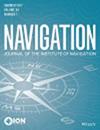基于准轨道固定太阳辐射压力模型的实时精确GPS轨道和时钟估计
IF 2
3区 地球科学
Q1 ENGINEERING, AEROSPACE
引用次数: 0
摘要
实时精确全球导航卫星系统(GNSS)轨道和时钟产品在科学和工业领域的实时GNSS应用中发挥着关键作用。与传统的轨道和时钟两步解分别生成不同,我们采用卡尔曼滤波同时估计实时轨道和时钟产物。为此,我们开发了一个GNSS数据处理软件,该软件可以在RINEX文件下以伪实时模式运行,一旦给定实时观测流,就可以在实时模式下运行。同时,建立了准定轨太阳辐射压力(SRP)模型。为了验证该软件和新SRP模型的性能,在三个月的时间内对60个跟踪站的全球网络进行了多次实验,以生成实时全球定位系统(GPS)轨道和时钟产品。然后,从精度和效率两个方面对结果进行了评估,这两个方面对实时精确GNSS应用至关重要。与国际GNSS服务(IGS)最终轨道相比,实时GPS轨道精度在径向、顺航迹和交叉航迹分量上分别为2.82 cm、5.45 cm和5.47 cm。时钟产品在标准偏差(STD)值方面的精度约为0.1 ns。此外,每个epoch的平均执行时间通常小于1.0 s,这保证了处理的高效率。本文章由计算机程序翻译,如有差异,请以英文原文为准。
Real-Time Precise GPS Orbit and Clock Estimation With a Quasi-Orbit-Fixed Solar Radiation Pressure Model
Real-time precise global navigation satellite system (GNSS) orbit and clock products play a key role for real-time GNSS-based applications, both in the scientific and industrial communities. Different from the typical two-step procedure to generate orbit and clock solutions separately, we estimate the real-time orbit and clock products simultaneously using a Kalman filter. For this purpose, we developed a GNSS data processing software that can run in pseudo-real-time mode with RINEX files and is ready to run in real-time mode once given the real-time observation stream. Meanwhile, a quasi-orbit-fixed solar radiation pressure (SRP) model is developed. In order to verify the performance of the software and the new SRP model, several experiments with a global network of 60 tracking stations over a time span of three months were conducted to generate real-time Global Positioning System (GPS) orbit and clock products. Then, the results were assessed in terms of accuracy and efficiency, both critical for real-time precise GNSS applications. Compared to the International GNSS Service (IGS) final orbits, the real-time GPS orbit accuracy was 2.82 cm, 5.45 cm, and 5.47 cm in the radial, along-track, and cross-track components, respectively. The precision of the clock product in terms of standard deviation (STD) value was about 0.1 ns. Moreover, the average execution time per epoch was usually less than 1.0 s, which ensures the high efficiency of the processing.
求助全文
通过发布文献求助,成功后即可免费获取论文全文。
去求助
来源期刊

Navigation-Journal of the Institute of Navigation
ENGINEERING, AEROSPACE-REMOTE SENSING
CiteScore
5.60
自引率
13.60%
发文量
31
期刊介绍:
NAVIGATION is a quarterly journal published by The Institute of Navigation. The journal publishes original, peer-reviewed articles on all areas related to the science, engineering and art of Positioning, Navigation and Timing (PNT) covering land (including indoor use), sea, air and space applications. PNT technologies of interest encompass navigation satellite systems (both global and regional), inertial navigation, electro-optical systems including LiDAR and imaging sensors, and radio-frequency ranging and timing systems, including those using signals of opportunity from communication systems and other non-traditional PNT sources. Articles about PNT algorithms and methods, such as for error characterization and mitigation, integrity analysis, PNT signal processing and multi-sensor integration, are welcome. The journal also accepts articles on non-traditional applications of PNT systems, including remote sensing of the Earth’s surface or atmosphere, as well as selected historical and survey articles.
 求助内容:
求助内容: 应助结果提醒方式:
应助结果提醒方式:


